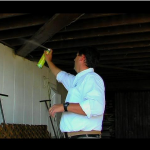There are some who use the strategy of preventive spraying on eaves or exposed wood that carpenter bees may infest. I think if it were that easy everyone would be doing it and this would not be such a hot topic. Every springtime we are reminded of just how difficult it can be to treat carpenter bees and for those who spray just before they emerge hoping to prevent them, well they scratch their heads as the bees seem to gnaw right through their chemical barrier. There are some effective wood treatment products that in theory should work but will they actually kill the damaging carpenter bee before it becomes a big problem?
I’m normally a very positive person but in this instance I have to say “the glass is half empty”. The real problem with standard liquid treatments is that they just won’t have the residual on the surface of the wood so that the bee will get a lethal dose. The other problem is that the carpenter bee does not ingest the wood when they drill, they simply rip it out bit by bit with their powerful jaws and let it go. This minimum amount of exposure is just not enough to kill the bee in most cases. If you are going to use this technique I would suggest using Timbor wettable powder. It can be painted, sprayed on or even blown in as a powder and it is very effective on other wood boring insects such as termites, carpenter ants etc. Now carpenter bees are not specifically on the label but it does state;
Target organisms
Tim-bor is effective for treatment of wood (and wood-foam composite structural components) against
decay fungi, including brown (i.e. Poria), white, and wet rots and wood-boring insects such as but not
limited to the following termites, beetles, and carpenter ants:
So while it is not on any label that I could find it is also not prohibited. Timbor works partly because that over time it penetrates further into the wood and insects like termites who eat wood ingest it and die. Carpenter ants do not eat the wood but do hew out galleries much like the carpenter bee-so why are they on the label and the bee is not. I think you’d have to ask the Nisus corporation about that but perhaps because the ants galleries are more extensive and they spend more time in the treated zones, who knows?
the wood and insects like termites who eat wood ingest it and die. Carpenter ants do not eat the wood but do hew out galleries much like the carpenter bee-so why are they on the label and the bee is not. I think you’d have to ask the Nisus corporation about that but perhaps because the ants galleries are more extensive and they spend more time in the treated zones, who knows?
The fact of the matter is that spraying the wood for carpenter bees rarely seems to work. Maybe the Timbor will kill them next year once it has had a chance to work into the timber further but who wants to wait that long? Those things sound like Black Hawk helicopters and who can enjoy a Sunday afternoon by the pool with those things hovering about? There are techniques you can employ to kill the bees and yes you can give Timbor a try too but to rid you of the insect copters that are infesting you now check out my article on the carpenter bee and see if you’re up for the task.




